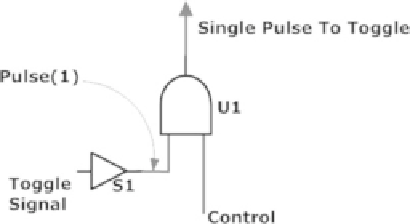Information Technology Reference
In-Depth Information
Fig. 4.13
Method of
controlled toggling
To stop multivibration, the figure suggests that two simultaneous pulses open the
AND gate U3, and therefore close the XOR gate U2, squelching multivibration.
Details of a practical simulation of this are provided in an appendix to this topic.
To stop multivibration, the Single Pulse To Toggle must occur within a given
time frame in this circuit, that is, as a pulse is emerging from the delay segments.
Communication to accomplish this might be done by synchronizing the state of the
recursive circuit and the application of a toggle signal.
Controlled toggling means that there is a second signal that must be true if
toggling is to occur. This may be implemented with a gate as in Fig.
4.13
; the output
of the gate produces the Single Pulse To Toggle.
The suggested circuits are not the only way of toggling, but these circuits have
the virtue of simplicity. They are a form of long-term memory with computational
possibilities and are very important to mental processing.
Sphere of Probability
A sphere of probability is an interesting way to visualize a single qubit; it shows the
relevant variables (See Fig.
4.14
). In a simulated qubit with an arbitrary mix of
frequency and phase, an operating point can be visualized as a vector
a
which will
be somewhere on a sphere. The bold with underline refers to a simulated qubit
vector, denoted as
a
. A physical qubit is denoted as
a
j
Indirectly, the projection of vector
a
on the z-axis is proportional to probability
of a sampled true: If
a
is on the axis and pointing up, there will be 100 %
probability for a true, which is a Boolean 1; if
a
is on the axis and pointing
down, there will be 0 % probability of a true or 100 % probability for a false,
which is Boolean 0. The figure shows approximately a 50-50 mix of the two
states, 0 and 1. A change of phase
>:
in the simulated qubit, causes the
vector to rotate about the z-axis, but this has no effect on a projection on the z-axis
or on the resultant probability.
Consider two multivibrators each with 50 % chances for true or false. When
read with independent random pulses there is a 25 % chance of ending up with one
of
00
,
01
,
10
,
11
. Four states are present. For n multivibrators, 2
n
possible states
φ
,ordelay
φ

Search WWH ::

Custom Search